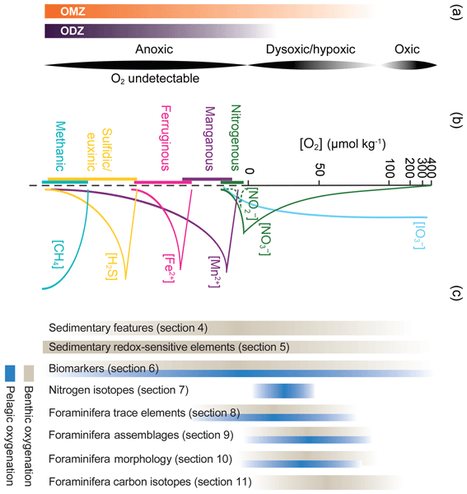The Mg/Ca ratio and how it responds to #ocean temperatures vary between species, and it might be that these differences are due to how they use energy.
https://www.science.org/doi/10.1126/sciadv.adq8425

Abstract. A growing body of observations has revealed rapid changes in both the total inventory and the distribution of marine oxygen over the latter half of the 20th century, leading to increased interest in extending oxygenation records into the past. The use of paleo-oxygen proxies has the potential to extend the spatial and temporal range of current records, constrain pre-anthropogenic baselines, provide datasets necessary to test climate models under different boundary conditions, and ultimately understand how ocean oxygenation responds beyond decadal-scale changes. This review seeks to summarize the current state of knowledge about proxies for reconstructing Cenozoic marine oxygen: sedimentary features, sedimentary redox-sensitive trace elements and isotopes, biomarkers, nitrogen isotopes, foraminiferal trace elements, foraminiferal assemblages, foraminiferal morphometrics, and benthic foraminiferal carbon isotope gradients. Taking stock of each proxy reveals some common limitations as the majority of proxies functions best at low-oxygen concentrations, and many reflect multiple environmental drivers. We also highlight recent breakthroughs in geochemistry and proxy approaches to constraining pelagic (in addition to benthic) oxygenation that are rapidly advancing the field. In light of both the emergence of new proxies and the persistent multiple driver problem, the need for multi-proxy approaches and data storage and sharing that adhere to the principles of findability, accessibility, interoperability, and reusability (FAIR) is emphasized. Continued refinements of proxy approaches and both proxy–proxy and proxy–model comparisons are likely to support the growing needs of both oceanographers and paleoceanographers interested in paleo-oxygenation records.
#Halloween is soon and so is the beginning of a new #chapter of my #academic #career!
For this reason, I reintroduce one of my most significant first-authored #research articles (Davtian et al., 2021 #Paleoceanography and #Paleoclimatology):
https://doi.org/10.1029/2020PA004077
More details in the #thread below: (1/15)
#Science
#ScienceMastodon #AcademicMastodon
#Paper #Scientific #Publication
#PaleoClimate #ClimateChange
#ClimateProxies #SeaSurfaceTemperature
#NorthAtlantic #AtlanticOcean #Atlantic #Ocean
Paleoceanography (Paleogeography 🦕)
Paleoceanography is the study of the history of the oceans in the geologic past with regard to circulation, chemistry, biology, geology and patterns of sedimentation and biological productivity. Paleoceanographic studies using environment models and different proxies enable the scientific community to assess the role of the oceanic processes in the global clim...
Marine Isotope Stage 13 (Glaciology 🗻)
Marine Isotope Stage 13 or MIS 13 is a Marine isotope stage in the geologic temperature record, in Britain covering the Cromerian interglacial period between ~524,000 and 474,000 years ago. It is split into three substages, MIS 13a MIS 13b, and MIS 13c. Some records indicate that MIS 13a was an unst...
https://en.wikipedia.org/wiki/Marine_Isotope_Stage_13
#MarineIsotopeStage13 #Glaciology #Interglacials #Paleogeography #Paleoceanography #Paleoclimatology
Marine Isotope Stage 13 (Paleogeography 🦕)
Marine Isotope Stage 13 or MIS 13 is a Marine isotope stage in the geologic temperature record, in Britain covering the Cromerian interglacial period between ~524,000 and 474,000 years ago. It is split into three substages, MIS 13a MIS 13b, and MIS 13c. Some records indicate that MIS 13a was an ...
https://en.wikipedia.org/wiki/Marine_Isotope_Stage_13
#MarineIsotopeStage13 #Glaciology #Interglacials #Paleogeography #Paleoceanography #Paleoclimatology
Marine Isotope Stage 11 (Paleogeography 🦕)
Marine Isotope Stage 11 or MIS 11 is a Marine Isotope Stage in the geologic temperature record, covering the interglacial period between 424,000 and 374,000 years ago. It corresponds to the Hoxnian Stage in Britain. Interglacial periods which occurred during the Pleistocene are investigated to b...
https://en.wikipedia.org/wiki/Marine_Isotope_Stage_11
#MarineIsotopeStage11 #Glaciology #Interglacials #Paleogeography #Paleoceanography #Paleoclimatology
Marine Isotope Stage 13 (Paleogeography 🦕)
Marine Isotope Stage 13 or MIS 13 is a Marine isotope stage in the geologic temperature record, in Britain covering the Cromerian interglacial period between ~524,000 and 474,000 years ago. It is split into three substages, MIS 13a MIS 13b, and MIS 13c. Some records indicate that MIS 13a was an ...
https://en.wikipedia.org/wiki/Marine_Isotope_Stage_13
#MarineIsotopeStage13 #Glaciology #Interglacials #Paleogeography #Paleoceanography #Paleoclimatology
Marine Isotope Stage 13 (Paleogeography 🦕)
Marine Isotope Stage 13 or MIS 13 is a Marine isotope stage in the geologic temperature record, in Britain covering the Cromerian interglacial period between ~524,000 and 474,000 years ago. It is split into three substages, MIS 13a MIS 13b, and MIS 13c. Some records indicate that MIS 13a was an ...
https://en.wikipedia.org/wiki/Marine_Isotope_Stage_13
#MarineIsotopeStage13 #Glaciology #Interglacials #Paleogeography #Paleoceanography #Paleoclimatology